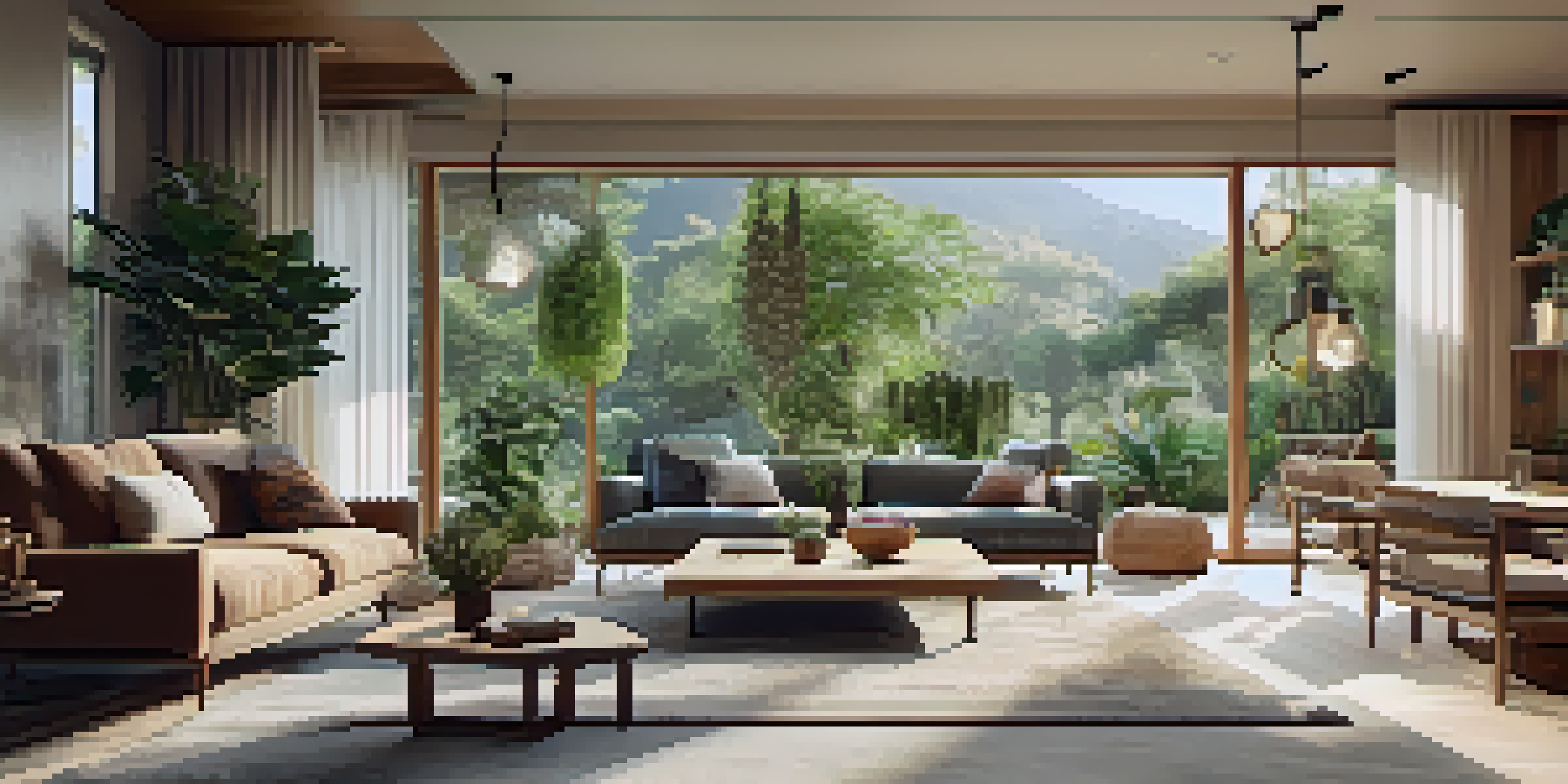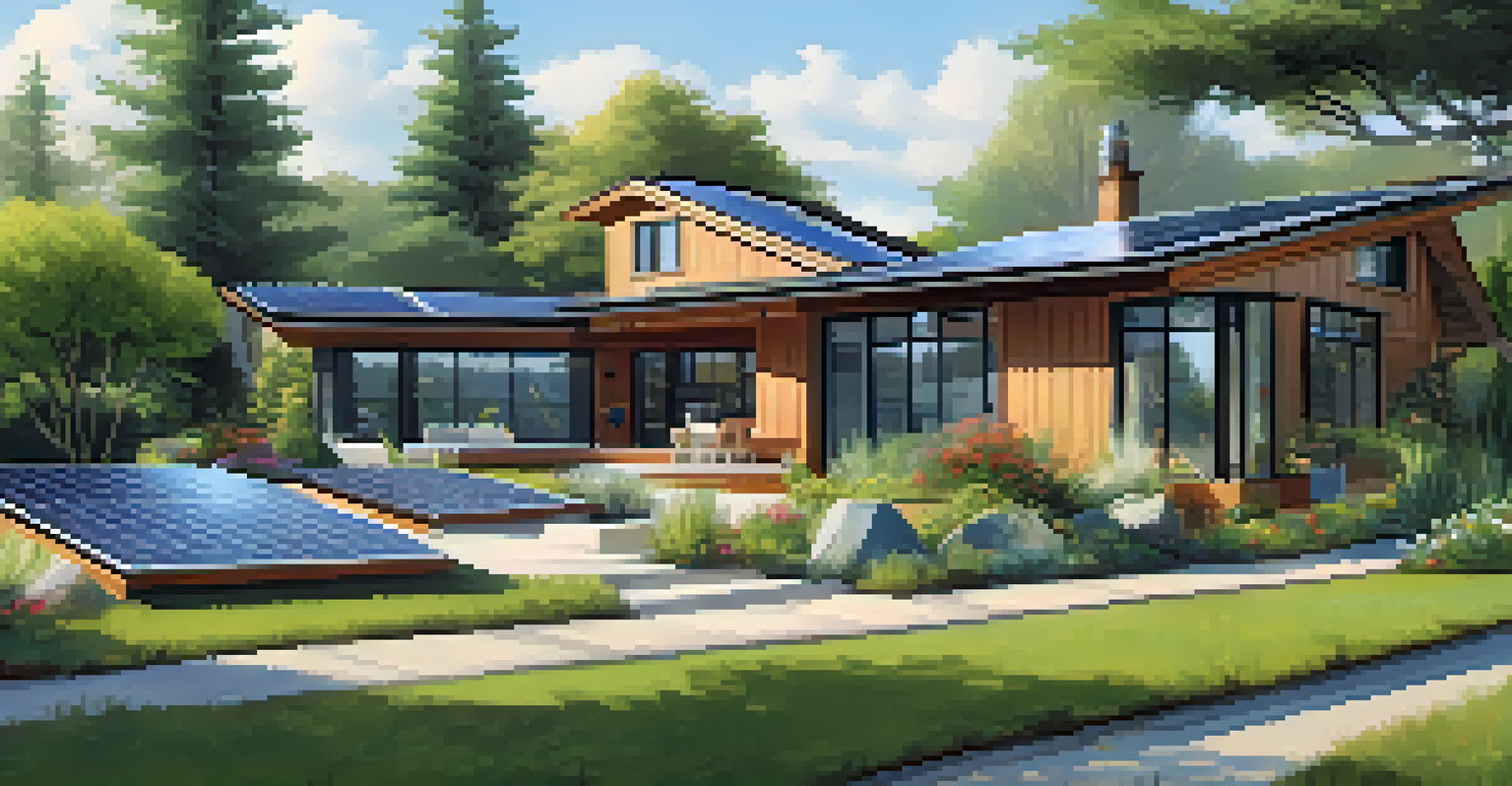Sustainable Home Design: Trends to Watch in 2023

Embracing Energy Efficiency with Smart Technology
In 2023, energy efficiency takes center stage, thanks to smart home technology. With devices that monitor energy usage and optimize consumption, homeowners can significantly reduce their carbon footprint while saving on utility bills. Imagine a smart thermostat that learns your schedule and adjusts temperatures accordingly, ensuring comfort without waste.
The greatest threat to our planet is the belief that someone else will save it.
Moreover, advancements in home automation allow for seamless control over lighting and appliances, further promoting energy conservation. Picture being able to turn off lights or appliances remotely via your smartphone, even when you're away from home. This level of control not only enhances convenience but also supports sustainable living practices.
As these technologies become more affordable and accessible, the trend toward energy-efficient homes will likely continue to grow. Consumers are increasingly prioritizing smart solutions, making this an essential aspect of modern home design.
Incorporating Sustainable Materials into Home Construction
Sustainable materials are gaining popularity as homeowners become more eco-conscious. From bamboo flooring to recycled steel, these materials not only reduce environmental impact but also often bring unique aesthetic appeal. For instance, bamboo is not only a renewable resource but also incredibly durable and stylish.

Another exciting development is the use of reclaimed materials, which adds character to homes while minimizing waste. Imagine transforming salvaged wood from an old barn into beautiful beams or flooring in your modern living space. This trend not only tells a story but also supports local artisans and reduces the demand for new resources.
Smart Tech Enhances Energy Efficiency
Homeowners can significantly reduce their carbon footprint and utility bills through smart technology that optimizes energy consumption.
As we move through 2023, expect to see more architects and builders prioritizing sustainable materials in their designs. This shift not only benefits the environment but also caters to a growing market of consumers who value sustainability.
The Rise of Biophilic Design and Indoor-Outdoor Living
Biophilic design is all about connecting people with nature, and it’s becoming increasingly popular in home design. This trend encourages the incorporation of natural elements, such as plants and water features, to create calming living spaces. Think of a home with large windows that offer stunning views of the outdoors, inviting nature inside.
Sustainability is not a destination, but a journey of continuous improvement.
In 2023, homeowners are also seeking seamless transitions between indoor and outdoor spaces. Imagine an open-concept living area that flows effortlessly into a lush garden or patio. This not only enhances the aesthetic of a home but also promotes a healthier lifestyle by encouraging outdoor activities.
As more people recognize the mental health benefits of nature, biophilic design will continue to shape sustainable home trends. Homeowners are increasingly valuing spaces that foster a sense of peace and well-being.
Utilizing Renewable Energy Sources for Homes
The shift towards renewable energy sources is gaining momentum in 2023, with solar panels leading the charge. Homeowners are increasingly investing in solar technology, which not only reduces reliance on fossil fuels but also significantly lowers energy costs. Imagine generating your own electricity while also contributing to a greener planet!
Wind energy is also making its way into residential design, particularly in areas with favorable conditions. Small residential wind turbines can supplement energy needs, allowing homeowners to harness natural resources efficiently. This blend of energy sources supports a more resilient energy grid and promotes sustainability.
Sustainable Materials Gain Popularity
Eco-conscious homeowners are increasingly choosing sustainable materials like bamboo and reclaimed wood for their aesthetic and environmental benefits.
As technology improves and costs decrease, renewable energy sources will become more accessible to the average homeowner. This trend not only reflects a commitment to sustainability but also offers long-term financial benefits.
Water Conservation Features in Home Design
Water conservation is becoming a crucial aspect of sustainable home design in 2023. With growing concerns about water scarcity, features like rainwater harvesting systems and greywater recycling are gaining traction. These systems allow homeowners to collect and reuse water for irrigation or other non-potable uses, reducing overall water consumption.
Additionally, low-flow fixtures and smart irrigation systems help minimize water waste in everyday use. Picture a home equipped with faucets and toilets designed to use significantly less water without sacrificing performance. This not only benefits the environment but also helps homeowners save on their water bills.
As awareness of water conservation grows, more builders will integrate these features into their designs. This trend not only addresses environmental concerns but also encourages responsible resource management.
The Shift Towards Smaller, More Efficient Homes
In 2023, there’s a noticeable shift towards smaller, more efficient homes, often referred to as downsizing. Many homeowners are realizing that less can be more, as smaller spaces often require fewer resources to build and maintain. Imagine living in a cozy, well-designed home that meets all your needs without the excess space that often goes unused.
This trend is also tied to the minimalist movement, where individuals focus on quality over quantity. By choosing to live in smaller homes, people can invest in high-quality, sustainable materials and furnishings that reflect their values. It’s about creating a space that is both functional and fulfilling.
Community Living Promotes Sustainability
New developments focused on shared resources and green spaces foster a sense of community while encouraging sustainable living practices.
As societal values shift towards sustainability and simplicity, expect to see more innovative designs that maximize small spaces. This trend not only promotes eco-friendliness but also encourages a lifestyle that prioritizes experiences over possessions.
Community-Oriented Sustainable Living Developments
Community-oriented sustainable living is emerging as a significant trend in 2023. Many new developments emphasize shared resources and green spaces, fostering a sense of community while promoting sustainability. Imagine a neighborhood with communal gardens, shared solar panels, and spaces for social gatherings, all designed with eco-friendly principles in mind.
These developments often include features like electric vehicle charging stations and bike paths, encouraging residents to adopt more sustainable transportation methods. By creating environments that support green living, communities can collectively reduce their carbon footprint while enhancing quality of life.

As more people seek connectedness and sustainability, community-driven projects will likely continue to flourish in the housing market. This trend reflects a growing awareness that sustainable living is not just an individual effort but a collective responsibility.
The Role of Sustainable Landscaping in Home Design
Sustainable landscaping is increasingly recognized as a vital component of home design in 2023. Homeowners are opting for native plants and drought-resistant landscaping to create beautiful outdoor spaces that require less water and maintenance. Imagine a garden filled with colorful native flowers that thrive naturally in your local climate, enhancing biodiversity.
In addition to aesthetics, sustainable landscaping practices support the local ecosystem. By choosing plants that attract pollinators and provide habitats for wildlife, homeowners can contribute positively to their environment. This approach not only beautifies the home but also fosters a connection with nature.
As awareness of environmental issues grows, expect to see more emphasis on sustainable landscaping in home designs. This trend not only enhances the home's curb appeal but also promotes a healthier ecosystem.